
Looking for an authentic Bulgarian salad recipe that’ll transport your taste buds straight to the Balkans? This vibrant, chunky salad combines garden-fresh vegetables with tangy feta for a flavor explosion you won’t forget.
Bulgarian salad, also known as Shopska salata, is the national dish of Bulgaria and for good reason. It’s a celebration of simple, fresh ingredients that come together in perfect harmony. Crisp cucumbers, juicy tomatoes, and crunchy bell peppers form the base, while salty feta cheese (sirene) crowns this colorful creation. Unlike Greek salad, the Bulgarian version typically skips the olives and oregano, letting the fresh produce and cheese shine.
You’ll love how this refreshing salad pairs with grilled meats or stands alone as a light meal. It’s perfect for summer gatherings but delicious year-round, offering a healthy dose of vitamins with every bite.
What Is Bulgarian Salad?
Bulgarian salad, known locally as “Shopska Salata,” is Bulgaria’s national dish and a staple throughout the country. This vibrant salad features crisp cucumbers, juicy tomatoes, bell peppers, and red onions topped with a generous sprinkle of sirene (Bulgarian white cheese similar to feta). The ingredients are chopped into chunks rather than small pieces, giving the salad a rustic presentation that highlights each component.
The beauty of Bulgarian salad lies in its simplicity. Unlike many Western salads, it contains no lettuce or leafy greens. Instead it celebrates the pure flavors of garden-fresh vegetables with minimal seasoning—typically just salt, sunflower oil, and sometimes a splash of red wine vinegar. The bright white cheese contrasts beautifully against the red tomatoes and green cucumbers, reflecting the colors of the Bulgarian flag.
Traditionally served as a starter or side dish, Shopska Salata appears at nearly every Bulgarian meal regardless of season. During summer months when produce is at its peak, the salad truly shines with farm-fresh ingredients. Restaurants throughout Bulgaria pride themselves on their version of this iconic dish, though the core elements remain consistent across variations.
What distinguishes Bulgarian salad from similar Mediterranean salads is the exact preparation method and the prominent role of sirene cheese. Rather than being cubed and mixed in, the cheese is finely grated or crumbled over the top, creating a snow-like blanket that gradually integrates with the vegetables as you eat.
Key Ingredients For Authentic Bulgarian Salad
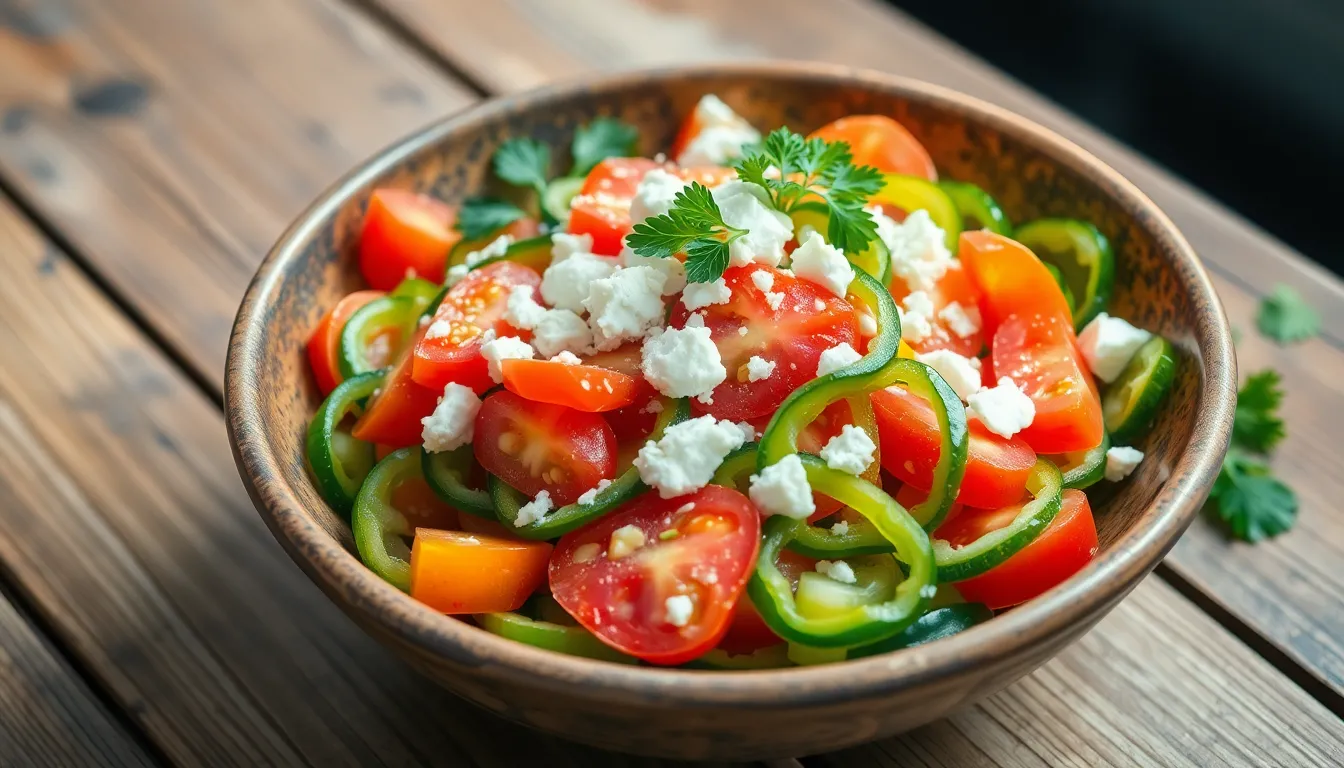
Creating an authentic Bulgarian Shopska salad requires just a handful of fresh ingredients that showcase the essence of Bulgarian cuisine. Each component plays a vital role in achieving the classic flavor profile that has made this dish Bulgaria’s beloved national salad.
Bulgarian White Cheese (Sirene)
Sirene is the crown jewel of Bulgarian salad and what truly sets it apart from other Mediterranean variations. This crumbly white cheese resembles feta but has its own distinct characteristics with a slightly tangier flavor and firmer texture. Traditional Bulgarian sirene is made from sheep’s milk though cow’s milk versions are also common. The cheese is grated or finely crumbled over the top of the salad rather than mixed in creating the signature snow-capped appearance that gives Shopska salad its visual appeal. If you can’t find authentic sirene at specialty stores or Eastern European markets good quality Greek or French feta makes an acceptable substitute.
Fresh Tomatoes And Cucumbers
The foundation of any Bulgarian salad begins with perfectly ripe tomatoes and crisp cucumbers. Look for tomatoes that are firm yet juicy preferably local or garden-grown varieties with rich flavor and natural sweetness. Bulgarian cooks typically choose medium to large tomatoes cut into chunky wedges rather than small diced pieces. For cucumbers the traditional choice is English or Persian varieties with thin edible skins and fewer seeds. These cucumbers provide the refreshing crunch that balances the juicy acidity of the tomatoes. Both vegetables should be at peak ripeness for the most authentic flavor experience.
Bell Peppers
Green bell peppers add a distinctive crunch and slight bitterness that balances the sweetness of the other vegetables in Bulgarian salad. Traditional recipes specifically call for green peppers rather than the sweeter red yellow or orange varieties. The peppers are typically cut into strips or chunks similar in size to the tomatoes and cucumbers. Some regional variations might include roasted peppers for a smokier dimension but the classic preparation features raw green peppers for their bright flavor and firm texture. Their mild peppery bite adds complexity to the overall flavor profile of the salad.
Red Onions
Red onions provide the sharp aromatic element that gives Bulgarian salad its depth of flavor. These are typically sliced thinly or chopped into small pieces to distribute their pungent taste throughout the dish without overwhelming the other ingredients. Many Bulgarian home cooks will soak the sliced onions briefly in cold water before adding them to the salad to temper their intensity while preserving their essential flavor. The vibrant purple color of red onions also enhances the visual appeal of the finished dish creating a beautiful contrast against the green peppers bright red tomatoes and white cheese.
Fresh Herbs
Parsley serves as the primary herb in authentic Bulgarian salad adding a fresh grassy note that brightens the entire dish. Unlike Greek salads which rely heavily on oregano Bulgarian salad features a more subtle herbal presence with finely chopped fresh parsley sprinkled throughout or used as a garnish. Some regional variations might include a small amount of fresh mint or dill but these are less traditional. The parsley not only adds flavor but also contributes visual interest with its vibrant green color. For the most authentic preparation choose flat-leaf (Italian) parsley rather than the curly variety as it offers a cleaner more pronounced flavor that complements the vegetables without competing with them.
Equipment Needed

Preparing Bulgarian Shopska salad requires minimal equipment which makes it an accessible dish for cooks of all experience levels. You’ll need:
- Large mixing bowl – For tossing all vegetables together with the dressing
- Sharp chef’s knife – Essential for chopping vegetables into the characteristic chunky pieces
- Cutting board – A sturdy surface for preparing all ingredients
- Cheese grater – For creating the traditional snow-like topping of sirene or feta cheese
- Measuring spoons – To portion oil and vinegar accurately
- Serving platter – A wide, shallow dish showcases the colorful vegetables beautifully
- Wooden spoons or salad servers – For gently mixing and serving without bruising the vegetables
The beauty of Bulgarian salad lies in its simplicity. Your kitchen likely already contains everything necessary to create this traditional dish. No specialized tools or equipment are required which aligns perfectly with the straightforward nature of Bulgarian cuisine.
Ingredients
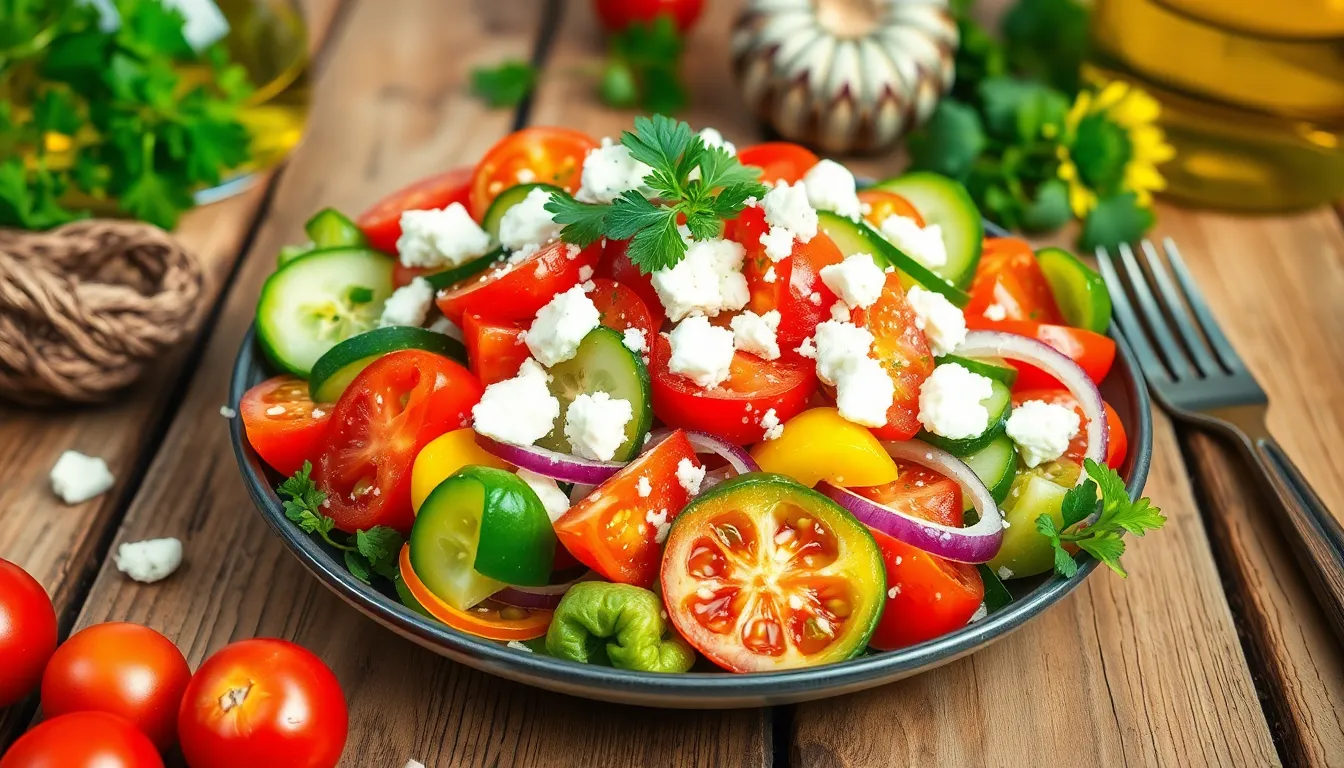
To create an authentic Bulgarian Shopska salad you’ll need these simple fresh ingredients:
- 3 medium tomatoes ripe and firm
- 2 cucumbers preferably English or Persian
- 1 green bell pepper
- 1 red onion medium-sized
- 200g sirene or feta cheese crumbled
- 2 tablespoons fresh parsley chopped
- 2 tablespoons sunflower oil (or extra virgin olive oil)
- 1 tablespoon red wine vinegar (optional)
- Salt to taste
- Black pepper freshly ground (optional)
The quality of vegetables significantly impacts the final flavor of your Bulgarian salad. Select tomatoes that are ripe but still firm to maintain their shape when chopped. Look for cucumbers with minimal seeds and crisp texture. Bulgarian cuisine traditionally uses sunflower oil for dressing but olive oil makes an excellent substitute if preferred.
Sirene cheese is the authentic choice for this recipe but feta serves as a widely available alternative that closely mimics the tangy briny flavor profile of traditional Bulgarian white cheese. The cheese should be crumbly in texture so it can be grated or sprinkled over the top of the finished salad creating the characteristic snow-like appearance.
For the most authentic experience use ingredients at the peak of their season when flavors are most vibrant. Summer vegetables directly from a farmers market or garden will elevate your Shopska salad to its traditional Bulgarian glory.
How To Make Bulgarian Salad
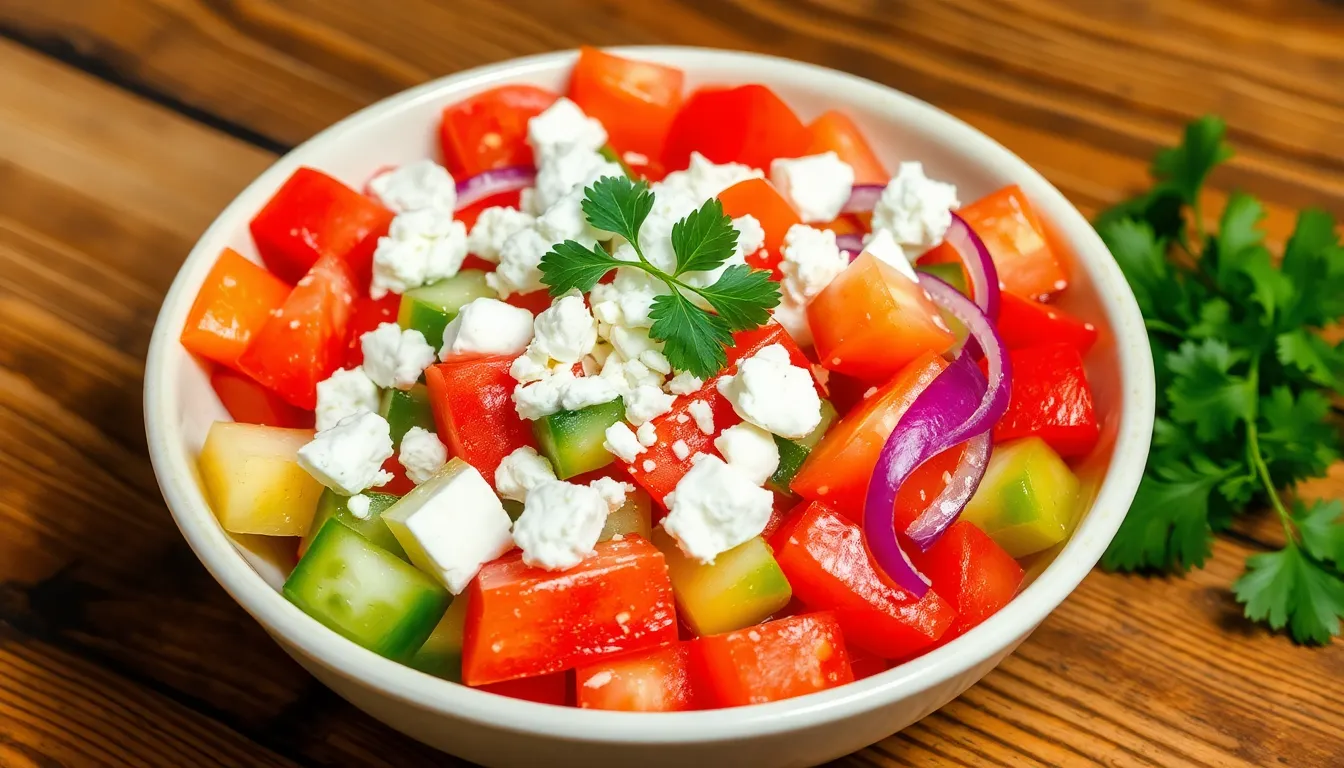
Creating an authentic Bulgarian salad (Shopska salata) requires minimal effort but delivers maximum flavor. Follow these simple steps to bring this Bulgarian classic to your table.
Preparing The Vegetables
Start by washing all your vegetables thoroughly under cold running water. Cut the tomatoes into bite-sized chunks or wedges, removing the seedy cores if desired for a less watery salad. Slice the cucumbers into half-moons about ¼-inch thick—there’s no need to peel them if using thin-skinned varieties. Dice the green bell pepper into small squares after removing the seeds and white membrane. Slice the red onion thinly into half-rings or chop it finely depending on your preference. Roughly chop the fresh parsley, setting aside a few whole leaves for garnish. The key to authentic Bulgarian salad lies in cutting vegetables into rustic, chunky pieces rather than fine dice, allowing each component to retain its distinct texture and flavor.
Making The Dressing
Bulgarian salad features a remarkably simple dressing that lets the fresh vegetables shine. Pour 2-3 tablespoons of high-quality sunflower oil into a small bowl. Add a pinch of salt to taste—remember that the cheese will add saltiness later. If using red wine vinegar, add just 1-2 teaspoons for a subtle tang that won’t overpower the vegetables. Whisk these ingredients together briefly until combined. Traditional Bulgarian salad dressing intentionally remains minimal and understated, focusing on improving rather than masking the natural flavors of the fresh produce.
Assembling The Salad
Place all your prepared vegetables in a large mixing bowl. Drizzle the dressing over the vegetables and toss gently to coat everything evenly. Transfer the dressed vegetables to a shallow serving platter or bowl that will showcase the colorful ingredients. Grate or crumble the sirene or feta cheese directly over the top of the salad, creating the characteristic snow-like layer that gives Shopska salad its distinctive appearance. Sprinkle with additional chopped parsley and a light drizzle of sunflower oil just before serving. For an authentic presentation, avoid tossing the cheese with the vegetables—the white layer should remain visible on top until the salad is served and individual diners mix it in themselves.
Tips For The Perfect Bulgarian Salad
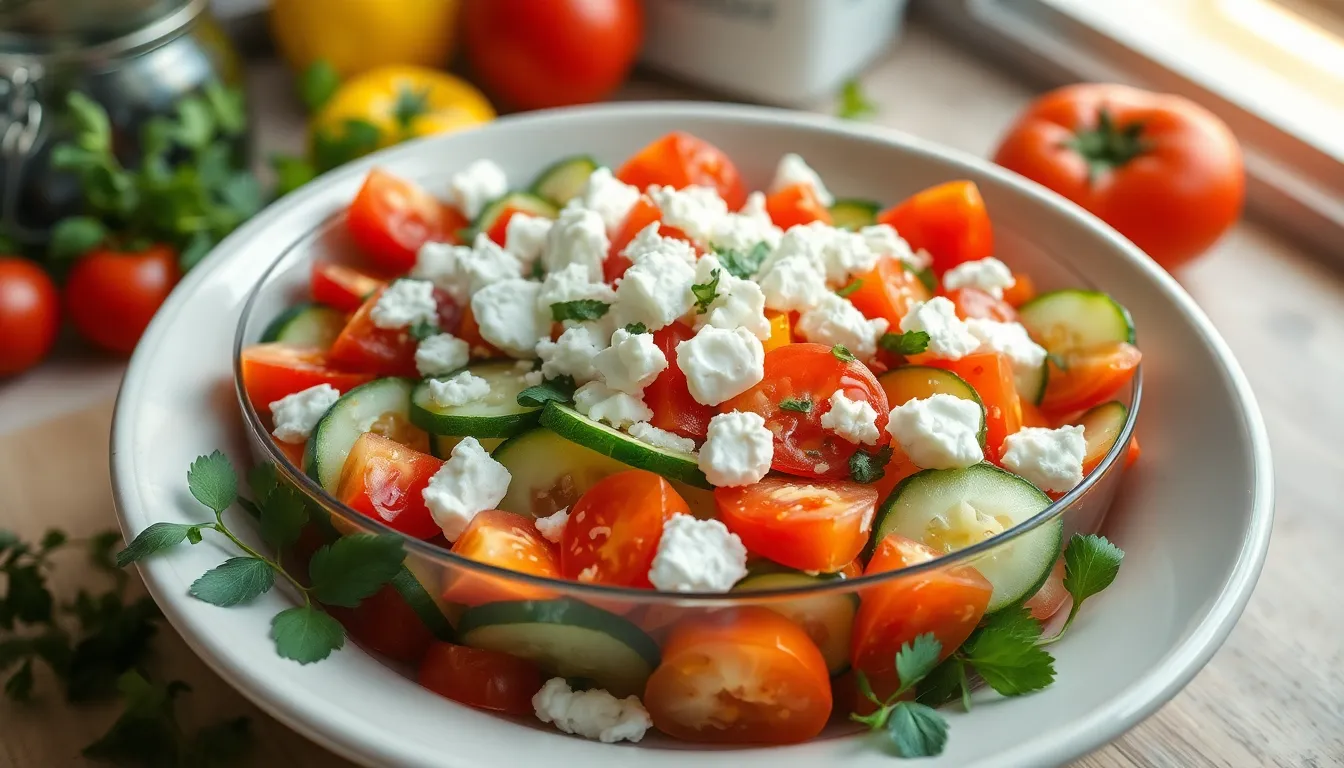
Choose peak-season produce for the most authentic flavor. Bulgarian salad relies heavily on the quality of its vegetables so visit farmers’ markets during summer months when tomatoes and cucumbers are at their juiciest.
Cut vegetables into rustic chunks rather than small pieces. Traditional Shopska salata features vegetables in roughly 1-inch pieces which creates the perfect texture contrast with the crumbled cheese.
Balance the flavors carefully when adding onion. Too much can overpower the delicate taste of other ingredients while too little won’t provide the necessary aromatic kick. Start with a quarter of a medium red onion and adjust according to your preference.
Chill ingredients before preparation but never dress the salad until just before serving. Refrigerating the vegetables for about 30 minutes enhances their crispness and creates that refreshing quality Bulgarians love.
Grate the cheese at the last moment to preserve its texture and visual appeal. The fine snow-like layer of sirene or feta should blanket the colorful vegetables below without melting or becoming soggy.
Use sunflower oil rather than olive oil for authenticity. Bulgarian cuisine traditionally employs sunflower oil which offers a lighter profile that doesn’t compete with the vegetables’ natural flavors.
Allow the salad to rest for 5-10 minutes after assembly. This brief resting period lets the salt draw out some moisture from the vegetables creating a light natural juice at the bottom of the bowl.
Serve at room temperature rather than cold from the refrigerator. Vegetables release their full flavor when not ice-cold which allows you to experience the true taste of Shopska salata.
Prepare only what you’ll eat immediately as Bulgarian salad doesn’t store well once dressed. The tomatoes continue releasing juice which makes leftovers watery and less appealing.
Present in a shallow bowl or on a flat plate to showcase the colorful layers. The traditional presentation highlights the white cheese sprinkled over the vibrant red green and purple vegetables beneath.
Variations Of Bulgarian Salad

While the classic Shopska salad holds a special place in Bulgarian cuisine, several regional and seasonal variations exist throughout the country. These adaptations reflect local produce availability and personal preferences while maintaining the essence of this beloved dish.
Traditional Shopska Salad
The classic Shopska salad features a simple yet perfect combination of chunky tomatoes, cucumbers, bell peppers, and red onions topped with a generous layer of grated sirene cheese. This traditional version relies on minimal seasoning with just sunflower oil, salt, and sometimes a splash of red wine vinegar. Fresh parsley adds a touch of herbal brightness to complete the authentic presentation. Bulgarians typically serve this version year-round at family gatherings and restaurants alike. The proportions remain fairly consistent across the country with roughly equal amounts of tomatoes and cucumbers forming the base of the salad. Many traditional recipes specifically call for the vegetables to be cut into rustic chunks rather than finely diced to maintain their distinct textures and flavors.
Summer Bulgarian Salad
When summer heat blankets Bulgaria, locals often prepare a lighter version that emphasizes the season’s bounty. This summer variation incorporates additional vegetables like fresh corn kernels, garden-ripe zucchini, or even watermelon for a refreshing twist. You might find roasted red peppers substituted for raw green peppers, adding a smoky sweetness that complements the juicy tomatoes. Some coastal regions incorporate locally grown herbs such as dill or mint for extra freshness. The dressing often becomes lighter too, with lemon juice sometimes replacing vinegar for a brighter flavor profile. The cheese portion may be reduced slightly to create a more vegetable-forward dish that serves as a cooling meal during hot weather. This variation pairs beautifully with grilled fish or can stand alone as a light dinner with crusty bread on sweltering evenings.
Serving Suggestions

Shopska salad shines as both a standalone dish and an accompaniment to traditional Bulgarian cuisine. Present this colorful creation on a wide shallow plate or bowl to showcase its vibrant layers and allow guests to appreciate the snow-like cheese topping before mixing.
For an authentic Bulgarian dining experience serve Shopska salad alongside grilled meats like kebapche (grilled minced meat rolls) or kyufte (Bulgarian meatballs). The fresh crisp vegetables and tangy cheese provide a perfect contrast to the rich savory flavors of these traditional dishes.
Pair your Bulgarian salad with warm crusty bread for a light lunch option. Traditional Bulgarian bread like pitka or a rustic country loaf works wonderfully for sopping up the flavorful juices that collect at the bottom of the salad bowl.
Shopska salad functions beautifully as the first course of a larger meal. Serve small portions before heartier main dishes such as moussaka or sarmi (stuffed cabbage rolls) to awaken the palate with its bright flavors.
During summer gatherings incorporate Shopska salad as part of a mezze-style spread. Place it alongside dips like tarator (cucumber yogurt soup) and kyopolou (roasted eggplant spread) for an impressive array of Bulgarian flavors.
For beverage pairings consider serving rakia (Bulgarian fruit brandy) or a crisp white wine from Bulgaria’s growing regions. The acidity in these drinks complements the fresh vegetables and tangy cheese perfectly.
Enhance your presentation by garnishing the plated salad with a few additional sprigs of fresh parsley or a light drizzle of high-quality sunflower oil just before bringing it to the table. This final touch adds visual appeal and reinforces the authentic Bulgarian character of the dish.
Storage Instructions

Bulgarian salad is best enjoyed immediately after preparation while the vegetables are at their freshest and most vibrant. The dressed salad does not keep well for extended periods due to the high water content of the tomatoes and cucumbers. If you need to store leftovers follow these guidelines for best results:
- Store any dressed salad in an airtight container in the refrigerator for up to 24 hours maximum
- Expect some liquid to collect at the bottom of the container as the vegetables release moisture
- The texture will soften considerably after storage with cucumbers losing their crispness
- The cheese may begin to dissolve into the accumulated juices
For optimal freshness consider preparing the components separately:
- Chop all vegetables and store them in separate containers without dressing
- Keep the grated cheese in its own container
- Combine and dress the ingredients just before serving
Room temperature salad offers the most authentic flavor experience. Remove any refrigerated salad about 15-20 minutes before serving to allow the flavors to fully develop. The cold temperature from refrigeration can dull the taste profile of the fresh vegetables and cheese.
If planning to serve Shopska salata at a gathering prepare the components ahead of time but assemble just before guests arrive. This preparation method preserves the traditional texture and vibrant appearance that makes Bulgarian salad so appealing.
Why You’ll Love This Bulgarian Salad Recipe
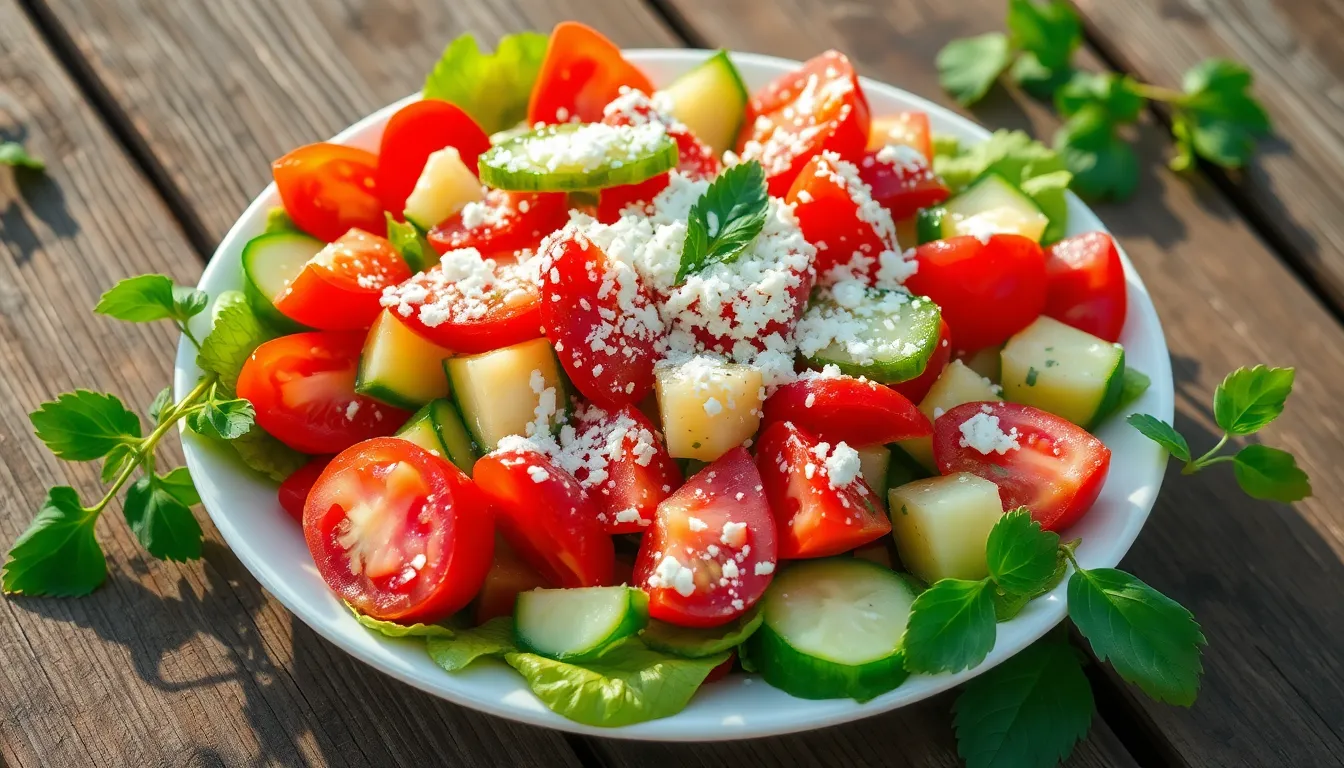
This Bulgarian Shopska salad offers an irresistible combination of freshness and flavor that will instantly transport you to the sunny Balkan countryside. Its vibrant colors create a feast for the eyes before you even take your first bite.
The simplicity of preparation makes this recipe perfect for busy weeknights when you need a nutritious side dish without spending hours in the kitchen. You’ll appreciate how quickly it comes together using just a few basic kitchen tools.
Fresh ingredients shine in this uncomplicated dish where every component plays an essential role. The juicy tomatoes and crisp cucumbers provide refreshing hydration while green peppers add a satisfying crunch to each forkful.
Health-conscious eaters will appreciate this nutrient-dense salad that’s naturally low in calories yet incredibly satisfying. The protein from the sirene cheese makes it substantial enough to serve as a light meal on its own.
Versatility is another standout quality of this Bulgarian classic. You can easily adjust the quantities based on preference or availability and pair it with virtually any main course from grilled meats to vegetarian options.
The unique presentation with finely grated cheese creating a snow-like topping sets this salad apart from other Mediterranean dishes. Your guests will be impressed by both its distinctive appearance and authentic flavor profile.
Seasonal adaptability allows you to enjoy this salad year-round using the best produce available. The recipe maintains its Bulgarian character while accommodating what’s fresh at your local market each season.
Cultural authenticity gives you the opportunity to experience a true taste of Bulgarian cuisine without leaving your home. This traditional recipe has been enjoyed throughout Bulgaria for generations and now you can share in this culinary heritage.
Conclusion
This Bulgarian Shopska salad brings a taste of Balkan tradition to your table with minimal effort and maximum flavor. The beauty lies in its simplicity – quality vegetables topped with tangy white cheese create a dish that’s both refreshing and satisfying.
You’ll find this salad incredibly versatile whether you’re serving it alongside grilled meats or enjoying it as a light meal on its own. The vibrant colors and crisp textures make it as visually appealing as it is delicious.
By following this authentic recipe you’re not just preparing a salad but participating in a culinary tradition that Bulgarians have treasured for generations. Give it a try and discover why this humble combination of ingredients has earned its place as Bulgaria’s beloved national dish.
Frequently Asked Questions
What is Bulgarian Shopska salad?
Shopska salad is Bulgaria’s national dish featuring fresh cucumbers, tomatoes, bell peppers, and red onions topped with sirene (white Bulgarian cheese similar to feta). Unlike Greek salad, it contains no olives or oregano, allowing the fresh vegetables and tangy cheese to shine. This simple, vibrant salad celebrates Bulgaria’s agricultural bounty and serves as both a starter and side dish throughout the country.
What makes Bulgarian salad different from Greek salad?
Bulgarian Shopska salad differs from Greek salad by omitting olives and oregano. It features cheese grated or crumbled on top creating a snow-like effect, rather than cheese chunks. The presentation is more rustic with vegetables cut into larger pieces. Shopska uses sunflower oil instead of olive oil and sometimes includes red wine vinegar. The focus remains on letting the fresh vegetable flavors take center stage.
What cheese is used in authentic Shopska salad?
Authentic Shopska salad uses sirene, a Bulgarian white brined cheese with a crumbly texture and tangy flavor. It’s similar to feta but typically made from sheep’s milk or a mixture of sheep and cow’s milk. The cheese is traditionally grated or finely crumbled over the top of the salad, creating a distinctive snow-like appearance. If unavailable, Greek or Bulgarian feta makes an excellent substitute.
How do you cut vegetables for Bulgarian salad?
For authentic Shopska salad, vegetables should be cut into rustic, chunky pieces rather than finely diced. Tomatoes and cucumbers are typically cut into 1-inch chunks or wedges. Bell peppers are sliced into strips or chunks, while red onions are thinly sliced or chopped. This chunky preparation maintains the vegetables’ integrity and creates the salad’s characteristic rustic presentation.
Can I prepare Shopska salad in advance?
Shopska salad is best prepared just before serving due to the high water content of its vegetables. For advance preparation, wash and cut vegetables and store them separately in the refrigerator. Add dressing and grate cheese only right before serving. If you must store dressed salad, it will keep for up to 24 hours in an airtight container, though the vegetables will soften and release water.
What oil is traditionally used in Bulgarian salad?
Sunflower oil is the traditional choice for authentic Shopska salad. Unlike many Mediterranean salads that use olive oil, Bulgarian cuisine historically favored sunflower oil due to its abundance in the region. It provides a lighter, more neutral flavor that allows the fresh vegetables and tangy cheese to remain prominent. While olive oil can be substituted, sunflower oil delivers the most authentic Bulgarian flavor profile.
What should I serve with Shopska salad?
Shopska salad pairs wonderfully with grilled meats like Bulgarian kebapche (grilled minced meat rolls) or kyufte (meatballs). Serve it with warm crusty bread for a light lunch or as a refreshing first course before heartier main dishes. It’s perfect for summer barbecues alongside grilled vegetables and can be part of a mezze-style spread with dips and appetizers. Traditional beverage pairings include rakia or crisp white wine.
Can I add other vegetables to Shopska salad?
While traditional Shopska salad has a specific ingredient list, regional and seasonal variations exist throughout Bulgaria. During summer, you might add fresh corn, zucchini, or even watermelon for a refreshing twist. Some versions include radishes or roasted peppers. While purists stick to the classic recipe, feel free to experiment with seasonal produce while maintaining the essential components of tomatoes, cucumbers, peppers, onions, and white cheese.
How should Shopska salad be presented?
Present Shopska salad on a wide, shallow plate or bowl to showcase its vibrant colors and distinctive layered appearance. The vegetables form the base, with the snow-like grated white cheese prominently displayed on top. The presentation should be rustic rather than precisely arranged. For the most authentic experience, serve at room temperature in a shallow ceramic dish, allowing diners to see the colorful vegetable chunks beneath the blanket of cheese.
Is Shopska salad healthy?
Yes, Shopska salad is exceptionally healthy. It’s packed with fresh vegetables rich in vitamins, minerals, and antioxidants. The minimal dressing of sunflower oil provides heart-healthy fats, while the protein from the cheese makes it more satisfying. It’s naturally low in calories yet nutrient-dense, making it perfect for those seeking a light, nutritious option. As a staple of the Mediterranean diet pattern, it contributes to the health benefits associated with this eating style.



